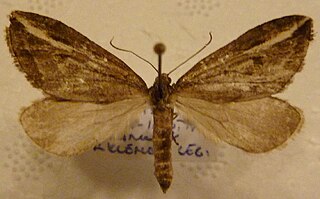Ocyrhoe or Ocyrrhoe (Ὠκυρρόη) refers to at least five characters in Greek mythology.

The streak is a moth of the family Geometridae. It is found in northern and western Europe and north Africa. It is common in Britain, but local and confined to the north in Ireland. The species was first described by Michael Denis and Ignaz Schiffermüller in 1775.

Larentiinae is a subfamily of moths containing roughly 5,800 species that occur mostly in the temperate regions of the world. They are generally considered a subfamily of the geometer moth family (Geometridae) and are divided into a few large or good-sized tribes, and numerous very small or even monotypic ones which might not always be valid. Well-known members are the "pug moths" of the Eupitheciini and the "carpets", mainly of the Cidariini and Xanthorhoini. The subfamily was described by Philogène Auguste Joseph Duponchel in 1845.

Chesias is a genus of moths in the family Geometridae described by Treitschke in 1825.

Chesiadini is a tribe of geometer moths under subfamily Larentiinae. The tribe was described by Stephens in 1850.

Chesias rufata, the broom-tip, is a moth of the family Geometridae. It was described by Johan Christian Fabricius in 1775. It has a wide range in central and western Europe, including Great Britain and Ireland. It is also found from Morocco to Asia Minor.The species prefers heaths, bushy slopes and rocky valleys which favour its foodplants.It is found up to 1,500m in the Alps.
Chesias capriata is a moth of the family Geometridae. It was described by Prout in 1904. It is found in Croatia, Italy, Slovenia and on Sardinia and Sicily.

Chesias isabella is a moth of the family Geometridae. It was described by Schawerda in 1915. It is found in France, Spain and Portugal.

Chesias linogrisearia is a moth of the family Geometridae. It is found on Sardinia.
Chesias rhegmatica is a moth of the family Geometridae. It was described by Prout in 1937. It is endemic to Cyprus.

Lyonia ovalifolia is a species of plant in the family Ericaceae. This plant is Native to Himalaya, Nepal, China, Japan, Cambodia, Myanmar, Thailand, Vietnam and Malaysia. It is known as Anyaar in India and Angeri in Nepal.

Maria Tudor is an opera in four acts composed by Antônio Carlos Gomes to an Italian-language libretto by Emilio Praga. The libretto is based on Victor Hugo's 1833 play Marie Tudor, which centers on the rise, fall and execution of Fabiano Fabiani, a fictional favourite of Mary I of England. The opera premiered on 27 March 1879 at La Scala, Milan, with Anna D'Angeri in the title role and Francesco Tamagno as Fabiani. The opera was a failure at its premiere and withdrawn, a heavy blow to Gomes who was in serious financial and family difficulties at the time. He returned to his native Brazil the following year.

Anna D'Angeri was an Austrian-born opera singer, who made Italy her adopted country and Italianized her surname. She had a brief (1873–1881) but eminent career singing leading soprano roles at the Vienna Hofoper and La Scala, Milan. Particularly admired by Verdi, she sang the role of Amelia in the premiere of the revised version of his Simon Boccanegra. She also sang the roles of Ortrud and Venus in the London premiere of Wagner's Lohengrin and Tannhäuser and created the roles of Jefte in Ponchielli's Il figliuol prodigo and Maria in Gomes's Maria Tudor.

Caryedon is a genus of pea and bean weevils in the beetle family Chrysomelidae. There are about 11 described species in Caryedon.
Imbrasos, is a river on the Greek island of Samos. The source of the river is located on mount Ambelos, near the village of Pyrgos. From there it flows southeast to Myli and then enters the sea on the south side of the island at Ireo. In ancient times, it had the epithet Parthenios, because the goddess Hera was said to have been born on its bank under a lygos tree. The site became the Heraion, which was the main ancient sanctuary on the island.
In Greek mythology, Imbrasus may refer to the following personages:
In Greek mythology, Chesias was the fairest of the nymphs, described as young and noble. She was the wife of the river-god Imbrasus and by him, became the mother of Ocyrrhoe, the nymph loved by Apollo.
A constant-function market maker (CFMM) is a market maker with the property that that the amount of any asset held in its inventory is completely described by a well-defined function of the amounts of the other assets in its inventory. As a result, both wealth and liquidity are known and fixed given relative prices. This has made these rules popular in prediction markets and decentralized finance.








